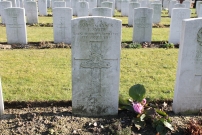| First Name: | Thomas | Last Name: | SMITH | |
|---|---|---|---|---|
| Date of Death: | 16/08/1917 | Lived/Born In: | Brentford | |
| Rank: | Private | Unit: | Royal Army Medical Corps 54th Field Ambulance | |
| Memorial Site: | ||||
Current Information:Age-28 7, Ealing Road, Brentford Brandhoek New Military Cemetery3, Belgium
Third Battle of Ypres This was a campaign fought between July and November 1917 and is often referred to as the Battle of Passchendaele, a village to the north-east of Ypres which was finally captured in November. It was an attempt by the British to break out of the Ypres salient and capture the higher ground to the south and the east from which the enemy had been able to dominate the salient. It began well but two important factors weighed against them. First was the weather. The summer of 1917 turned out to be one of the the wettest on record and soon the battlefield was reduced to a morass of mud which made progress very difficult, if not impossible in places. The second was the defensive arrangements of concrete blockhouses and machine gun posts providing inter-locking fire that the Germans had constructed and which were extremely difficult and costly to counter. For 4 months this epic struggle continued by the end of which the salient had been greatly expanded in size but the vital break out had not been achieved. The Battle of Langemarck This took place between 16th-18th August, 1917 and was the second general attack of 3rd Ypres. Although it did not rain during the two days of the battle itself there had been plenty of it in the preceding days and in many places the battlefield was a quagmire. On the left of the attack in the north-west of the Ypres salient there was considerable success, especially for the French Army which attacked on the left of the British, but the attack on the Gheluvelt Plateau, due east of Ypres, met determined German resistance and the early gains were soon reversed. On 16th August, 56th Division attacked at 4.45am on the right of the battle front, with 169 and 167 Brigades. They also had a brigade from 18th Division, which included the 54th Field Ambulance attached to form a southern defensive flank. However the operation ended in failure. A German counter attack drove them all back to their starting line. The Field Ambulances provided by the Royal Army Medical Corps were mobile medical units whose function was to provide stretcher bearers to collect the wounded and to give emergency aid before sending them back to Casualty Clearing Stations and then Base Hospitals. Working close to the front line they were often victims themselves of enemy fire, especially the stretcher bearers. Thomas Smith died from wounds on this day but he may have been wounded on an earlier date. |
||||
Other Photos: |
||||
| « Back to Search Results | ||||
| If you think any of the information shown here is incorrect, Click Here to submit your amends and comments | ||||





